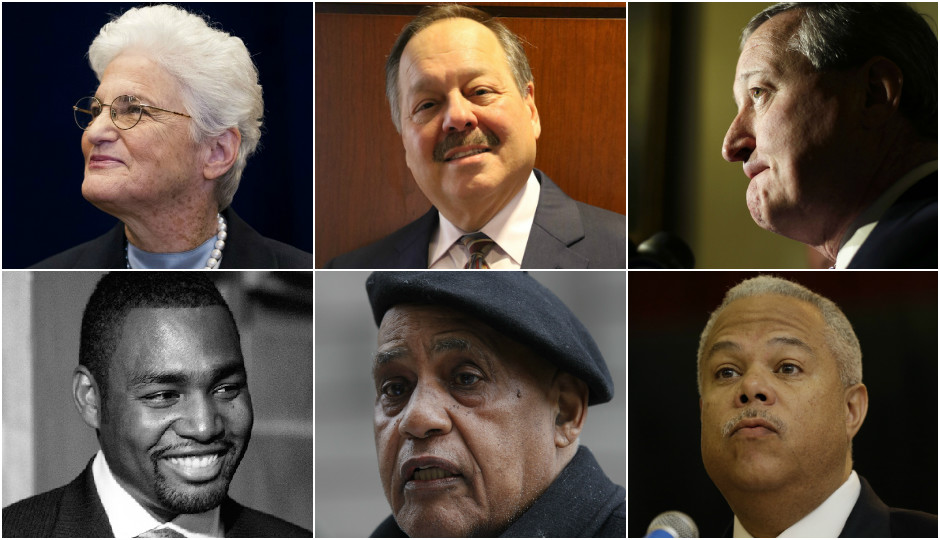The Brief: How Would Philly’s Mayoral Candidates Prevent Riots Here?
1. As Baltimore struggles to move on from this weeks’s riots, the mayor’s race turns to the issue of police and community relations.
The gist: Yesterday, more than one news outlet asked the candidates running for mayor: What do you think of the unrest in Baltimore? And what would you do to stop similar violence from spreading to Philadelphia? Riots and looting broke out in Baltimore Monday in the wake of the death of Freddie Gray, who some believe suffered a “rough ride” by police. “Rough rides” have happened here, only they go by a different name: “nickel rides.” To keep Philly from descending into chaos, the mayoral candidates recommended everything from equipping cops with body cameras to firing officers who use hate speech.
Why it matters: The issue of the strained relationship between cops and community members will probably continue to be a major part of the mayor’s race. Expect questions to be raised about mayoral candidate and former District Attorney Lynne Abraham’s record of not always prosecuting bad cops, as well as whether former City Councilman Jim Kenney can push for police reform after being endorsed by the city’s police union. And don’t be surprised if state Sen. Anthony Williams and former city solicitor Nelson Diaz attack Kenney or Abraham on these issues. (In fact, Diaz’ spokesman is already highlighting Kenney’s relationship with the Fraternal Order of Police on Twitter, saying, “Anyone who thinks the FOP is going to be a willing participant in reform here is kidding themselves. And who do they back again?”)
2. As Jim Kenney surges in special interest polls, Tony Williams’ super PAC allies sink more money into the campaign.
The gist: Kenney is now the frontrunner of the mayor’s race, according to two polls recently commissioned for him. At the same time, NewsWorks reports that a super PAC supporting Williams has upped its spending from $500,000 to $800,000 a week. An arm of the nonprofit Philadelphia School Partnership is also spending $1 million on pro-charter school ads.
Why it matters: Though the first charter school advertisement does not mention a specific candidate, Williams has been cast as the pro-charter candidate in the mayor’s race, while Kenney has been seen as the man for traditional public schools. So it’s likely that the ads will benefit Williams. What’s worse for Kenney is the relative ease with which the pro-Williams super PAC, which is funded by a trio of wealthy school reform advocates from the suburbs, has increased its spending. The pro-Kenney super PACs, which are largely funded by labor unions, already aren’t keeping up. If we’re to believe the pro-Kenney polls, how long will he be able to hold onto his lead?
3. Has the Philadelphia media portrayed Nelson Diaz as a faceless “angry brown man?”
The gist: Writing for Al Dia, Sabrina Vourvoulias points out that local journalists have used certain words to describe Nelson Diaz, the only Latino running for mayor. He’s been called “loud” repeatedly, as well as “angry,” “jilted,” strident” and “outlandish.” She also notes that this magazine has tweeted composite images of the mayoral candidates that did not include Diaz. “To Philly Mag’s credit, this second time I pointed it out, they fixed the Twitter card. Diaz being left out of that composite photo was, in all likelihood, an accident or tech problem to be fixed — but when it happens, we need to call attention to it anyway,” she writes.
Why it matters: We’ll let Vourvoulias explain. She says, “What I would like to point out is that, even if every one of those is 100 percent accurate, loudness and excitability are a Latino racial stereotype that we hate. It is also, most often, a stereotype brought up as a way to question our professionalism, or our ability to fit in at the higher reaches of a corporate structure.” Al Dia’s critique comes as the media faces a serious diversity problem. Minorities only make up 12 percent of newspaper employees nationwide, according to data from the American Society of News Editors.
